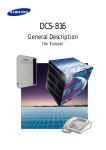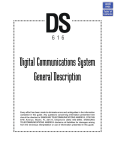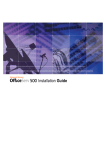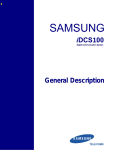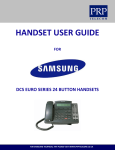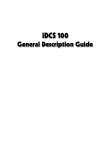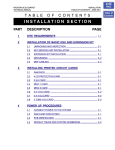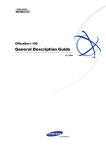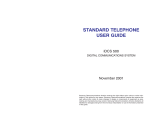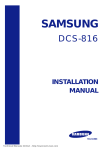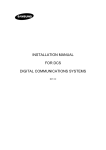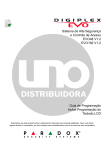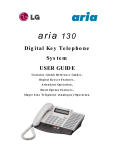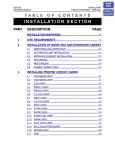Download DCS Compact LCD 24B Specifications
Transcript
DCS Compact II General Description DCS Compact II GENERAL DESCRIPTION DCS-Compact II General Description DCS Compact II General Description SAMSUNG ELECTRONICS CO. LTD. Publication Information Samsung Electronics reserves the right without prior notice to revise information in this publication for any reason. Samsung Electronics also reserves the right without prior notice to make changes in design or components of equipment as engineering and manufacturing may warrant. Copyright 1998 Samsung Electronics Co. Ltd All rights reserved. No part of this manual may be reproduced in any form or by any means – graphic, electronic or mechanical, including recording, taping, photocopying or information retrieval systems – without express written permission of the publisher of this material. March/98 DCS Compact II General Description TABLE OF CONTENTS CHAPTER 1 System Overview ...........................................1–1~1–6 1.1 Introduction .................................................................................................1–1 1.2 Size and Configuration ...............................................................................1–2 1.3 Technology...................................................................................................1–5 1.4 Programming................................................................................................1–6 CHAPTER 2 Hardware Descriptions ................................. 2–1~2–6 2.1 Key Service Unit ..........................................................................................2–1 2.2 Expansion Cabinet.......................................................................................2–2 2.3 Interface Cards ............................................................................................2–2 2.4 Specifications ...............................................................................................2–4 CHAPTER 3 Station Equipment.......................................... 3–1~3–5 3.1 LCD 24B Model Keyset (Figure 3–1) .........................................................3–1 3.2 STD 24B Model Keyset (Figure 3–2) .........................................................3–2 3.3 LCD 12B Model Keyset (Figure 3–3) .........................................................3–3 3.4 STD 12B Model Keyset (Figure 3–4) ........................................................3–3 3.5 Enhanced 6B Model Keyset (Figure 3–5) ..................................................3–4 3.6 48 Button Add–On Module (AOM) (Figure 3–6, 3–7) ............................3–4 3.7 Door Phone Interface Module (DPIM) And Door Phone (Figure 3–8, 3–9) .........................................................................................3–5 CHAPTER 4 Features ........................................................ 4–1~4–34 4.1 System Features ...........................................................................................4–1 4.2 System Feature Descriptions.......................................................................4–2 4.3 Station Features..........................................................................................4–21 4.4 Station Feature Descriptions.....................................................................4–22 4.5 Display Features ........................................................................................4–29 4.6 Display Feature Descriptions ...................................................................4–29 i DCS Compact II General Description Figures 1–1 DCS Compact II Configuration Matrix Table (with Analogue Trunks) 1–2 DCS Compact II Configuration Matrix Table (with Digital Trunks) 1–3 DCS Compact II System Configuration 2–1 DCS Compact II Key Service Unit 3–1 LCD 24B Model Keyset 3–2 STD 24B Model Keyset 3–3 LCD 12B Model Keyset 3–4 STD 12B Model Keyset 3–5 Enhanced 6B Model Keyset 3–6 48 Button Add–on Module 3–7 Display Phone and Add–on Module 3–8 Door Phone Interface Module 3–9 Door Phone ii DCS Compact II General Description Chapter 1. System Overview CHAPTER 1 System Overview 1.1 Introduction DCS Compact II, Digital Communication System, is a digital telephone system designed for small to medium–sized businesses. It can operate with the functionality of a square key system, PABX or a combination of both (hybrid). DCS Compact II employs the very latest DSP technology (Digital Signal Processors). DCS Compact II offers a variety of interface cards that allow connection to the public telephone network or private networks. These are generally referred to as trunk cards. Two types of telephones can be connected to the systems. Proprietary digital phones called "Keysets" connect to digital line interface cards (DLI). Standard telephone sets generally called "single line telephones" connect to single line interface cards (SLI). In addition, DLI station ports are used to connect peripheral devices such as door phones and add–on modules. Miscellaneous circuits are provided to allow such optional features as external paging, music on hold, background music, common audible devices, alarms and emergency power failure telephones. All DCS keysets utilize a single PCB with surface–mounted components assuring the highest product quality and long life. Samsung's customary large, easy–to– read displays and LEDs in the button design make them much easier to use. In many instances, sophisticated features are made simple through the use of friendly display prompts or push–on/push–off feature keys. NOTES 1. 'DCS' is the general term used in the text to refer to all systems. Any differences between the systems are indicated under separate headings ‘DCS Compact II’ 'DCS COMPACT' and 'DCS'. 2. It is not possible to expand from DCS Compact II to a DCS system nor to expand from DCS Compact to DCS Compact II. 1-1 DCS Compact II General Description Chapter 1. System Overview 1.2 Size and Configuration The DCS Compact II system consists of the basic Key Service Unit, an Expansion cabinet and Interface cards and Digital keysets. The Key Service Unit begins with eight (8) keyset ports expandable to 18 analogue C.O. line ports, or 24 lines if 4 BRI cards are used, or 32 stations. In addition, up to 8 keyset daughter boards may be added to the system along with the optional 2 SLI card. The Expansion cabinet has three Universal slots and one DCS slot for PRI or VM service, which provides the maximum configuration of 66 ports with analogue trunk lines or 88 ports with Digital trunk lines. Two types of telephones can be connected to the system: proprietary digital stations called "keysets" that connect to DLI (Digital Line Interface) ports and standard telephone sets, generally called "single line telephones", that connect to SLI (Single Line Interface) ports. The system also has an optional Miscellaneous card which provides Music on Hold facilities, two serial I/O ports and other useful facilities. The following charts (Figures 1–1 and 1–2) describe configurations using the basic Key Service Unit (KSU), an Expansion cabinet and expansion cards. However, by using the DCS's unique keyset daughter boards (KDbs), which are installed in the base of a digital keyset, the capacity of the system can be increased by one station per KDb. Installing a KDb–DLI adds another digital port while a KDb–SLI adds a single line port. Mix and match these two types of KDb to get up to a total of 8 KDbs in the system. Using this method allows the DCS Compact II to expand to a maximum of 64 stations. Adding the optional 2 SLI card to the KSU provides a further two SLI ports. The combination of the basic 008 KSU plus three expansion cards in the KSU plus three expansion cards and one DCS card in the Expansion cabinet plus 8 KDbs plus a 2 SLI card provides a maximum configuration of 88 ports plus Miscellaneous card. Configuration Notes 1. Only one 2 SLI card can be installed in the system. 2. Only one Miscellaneous card can be installed in the system. 3. Only three expansion cards can be installed in the Key Service Unit and the additional three expansion cards and a DCS card like as PRI can be installed in the Expansion cabinet. 4. Only 8 KDbs can be installed in the keysets connected to the 008 Basic KSU. 5. If a PRI card is installed in the DCS card slot, the last expansion slot of the Expansion cabinet should remain blank. 1-2 DCS Compact II General Description Chapter 1. System Overview Figure 1–1 DCS Compact II Configuration Matrix Table (with Analogue Trunks) Trunk Lines 36 Two Cabinets 30 24 18 12 KSU 6 0 8 16 18 26 34 42 50 58 66 58 66 Station Lines Figure 1–2 DCS Compact II Configuration Matrix Table (with Digital Trunks) Trunk Lines 70 40 Two Cabinets 32 24 16 KSU 8 0 8 16 18 26 34 Station Lines 1-3 42 50 DCS Compact II General Description Chapter 1. System Overview Figure 1–3 DCS Compact II System Configuration P4 D C S S L O T PLL DCS Compact II Configuration Notes 1. Only one 2 SLI card can be installed in the KSU. 2. Only one Misc card can be installed in the KSU. 3. Only three expansion cards can be installed in the KSU and the additional can be added in the Expansion cabinet when expanded. 4. Only 8 KDbs can be installed in the keysets connected to the Basic KSU. 5. ISDN cards(BRI and PRI) require a PLL card installed in the KSU. 6. A PRI card installed in the DCS slot of the Expansion cabinet requires the last expansion slot(the third one) remains blank. 7. A maximum of 40 keysets can be installed. 1-4 DCS Compact II General Description Chapter 1. System Overview 1.3 Technology Switching System switching is accomplished by means of a custom IC "engine" that provides 256 switchable digital channels. The engine is controlled by its own 16–bit Motorola MC 68000 microprocessor and switching control program. Each of the 256 digital channels is automatically assigned to carry voice or data as required by system operation in a PCM format. In addition to the 256 channels mentioned above, the systems also utilize Digital Signal Processors (DSPs). Each DSP may be configured by the switching control program as a DTMF sender, a DTMF receiver or as a C.O. tone detector on a per–call basis. Each engine chip contains 4 DSP channels. Four additional DSPs are added when a MISC card is installed. This means that the system contains a total of 8 DSP channels when fully expanded. The DSP channels are fully shared throughout the system as a common resource. Memory The systems operate using stored program control. This program is stored in EPROM chips. All specific customer data is stored in random access memory (RAM) which is protected against the loss of AC power to the system by an on– board battery backup system. Microprocessors DCS Compact II uses distributed processing. The primary processor of the system is a 16–bit Motorola MC68000 operating at a clock speed of 16 MHz. Secondary processing is in the some special cards like as BRI and also done in the keysets. The digital keyset uses a Hitachi H8 processor for data communication within the DCS Compact II. 1-5 DCS Compact II General Description Chapter 1. System Overview 1.4 Programming DCS Compact II is self–configuring. This means that when the power is switched ON, the system reads the types and locations of all installed cards and telephones and assigns default data to them. This data provides for system operation within seconds after power is switched ON. All trunks and stations are assigned according to the default numbering plan. This numbering plan is flexible and may be changed to suit customer requirements. The installing technician customizes this default data to meet the end user's requirements. The systems can be programmed from any LCD display keyset without interrupting system operation. There are three levels of programming: technician, customer and station. The technician level has access to all programs and can allow the customer access to system programs as needed. The technician and customer access are controlled by different security passcodes and access procedures. DCS Compact II also allows the use of a proprietary computer program called PCMMC. This permits a technician to program the system using a personal computer. PCMMC can be used on–site to modify the customer database or to download (save) the entire customer database to a file. This file can then be saved as a backup and be uploaded when required to restore the database. Through the use of modems, PCMMC can access a DCS Compact II system remotely (off–site) to make database changes or perform uploads or downloads of the customer database as if the technician were on–site. 1-6 DCS Compact II General Description Chapter 2. Hardware Descriptions CHAPTER 2 Hardware Descriptions 2.1 Key Service Unit (KP70D–M1/) The DCS Compact II Key Service Unit (KSU, Figure 2–1) is a single metal cabinet containing the following: • A power supply • Processing and switching • Eight 2B+D digital keyset interfaces • A removable MEM card, containing 2Mbyte Program memory, 512Kbyte Data memory with a back–up super capacitor, real time clock, a monitor LED and a RAM clear Figure 2–1 switch • One Internal Music source or an External Music interface for Music–on–Hold and Back–ground Music • One External Page interfaces • One general–purpose Dry contact • Three universal expansion slots, a MEM card slot, a 2 SLI card slot and a MISC card slot • 2 Champ connectors for external connections and other connectors for the Expansion cabinet and the Ring Generator Unit Ring Generator Unit RGU1 (KP70D–BRG1/) or RGU2 (KP70D–BRG2/) Two kinds of sinusoidal–waveform Ring Generator Units are available. KP70D– BRG1 drives 3W ring signals while the other provides 20W ring signals. The larger unit is required when a large number of single line telephones are operation behind the system. 2-1 DCS Compact II General Description MISC card Chapter 2. Hardware Descriptions MISC 1 (KP70D–BMI1/) or MISC 2 (KP70D–BMI2/) One dedicated slot in the Basic KSU is for an MISC card and two kinds of MISC cards are available. The MISC 1 card contains one additional External Music Interface for MOH or BGM, one additional External Page Interface, one Alarm Sensor Detection circuitry, 4 channels DTMF receiver, three General–purpose Dry contact relays, two RS232C Serial interfaces with connectors for PCMMC and SMDR and MODEM card interface. The MISC 2 card is similar to the MISC 1 card but is also equipped with a built–in 4–ch AA function. It is strongly recommended that this card be used in situations requiring heavy single line telephone use. MODEM card (KP70D–BMO/) One built–in MODEM card can be installed in a MISC card. PLL card (KP70D–BPL/) Any ISDN card, that is a BRI or a PRI, requires the PLL card which can be installed in a dedicated place on the KSU motherboard. 2.2 Expansion Cabinet (KP70D–M2/) One metal Expansion cabinet can be attached to the Key Service Unit for expansion. It consists of three Universal expansion slots and one DCS card slot for PRI or VM. The Expansion cabinet connects to the KSU via a 64–pin flat cable, two 2–wire power connections and a F–GND connection. It contains a 50–pin champ connector for external connections. 2.3 Interface Cards 2 SLI card (KP24D–B2S/) The 2 SLI card is installed in a dedicated slot on the KSU motherboard. The card provides two single line telephone interfaces equipped with Long Line protection and the ability to provide a loop disconnect signal. 2-2 DCS Compact II General Description 3 TRK card Chapter 2. Hardware Descriptions (KP70D–B3T/) The 3 TRK card provides three loop start C.O. interfaces with optional Caller ID relays. The first two C.O. interfaces are equipped with PFT relays. Each interface contains an interface for MPD or PRS which is optional. The MPD or PRS hybrid chips of the DCS system can be used. 6 TRK card (KP70D–B6T/) The 6 TRK card provides six loop start C.O. interfaces. The first two C.O. interfaces are equipped with PFT relays. Each interface contains an interface for MPD or PRS which is optional. The MPD or PRS hybrid chips of the DCS system can be used. 4 BRI card (KP70D–B4B/) The 4 BRI card contains four Basic Rate access ports, i.e. eight ISDN channels. Protocol is compatible for Euro–ISDN BRI. For S0 application, power feeding to ports is selectable by programming. 2 BRI card (KP70D–B2B/) The 2 BRI card contains two Basic Rate access ports, i.e. four ISDN channels. Protocol is compatible for Euro–ISDN BRI. For S0 application, power feeding to ports is selectable by programming. PRI card (KP70D–BP/) The PRI card contains one Primary Rate access ports, i.e. thirty ISDN channels. Protocol is compatible for Euro–ISDN PRI. 8 DLI card (KP70D–B8D/) The 8 DLI card provides eight DLI ports. 8 SLI card (KP70D–B8S/) The 8 SLI card provides eight SLI ports for industry–standard single line telephones and the ability to provide a loop disconnect signal. Please note that this card does not provide Long Line protection. 2-3 DCS Compact II General Description Chapter 2. Hardware Descriptions 6 MWSLI card (KP70D–B6S2/) Available from July, 1998 The 6 MWSLI card provides six SLI ports for industry–standard single line telephones and the ability to provide a loop disconnect signal and a message waiting signal. Please note that this card does not provide Long Line protection. KDb–DLI, KDb–SLI card The KDb–DLI board or KDb–SLI board, if installed in a digital keyset connecting to the Basic KSU, provides a second DLI or SLI port. 2.4 Specifications The following tables provide technical data for the DCS Compact II hybrid/key telephone system. Electrical Specifications AC INPUT 220 VAC ± 20%, 48–63 Hz or Free Input Voltage for some countries. POWER CONSUMPTION (MAX) 100 WATTS MAX DC OUTPUT FUSE RATING 2.0 AMP +5 VOLTS 2.5 AMPS MAX –5 VOLTS 0.5 AMPS MAX (on the Motherboard) –55 VOLTS 1.2 AMPS MAX –54 VOLTS 0.4 AMPS MAX 2-4 DCS Compact II General Description Chapter 2. Hardware Descriptions Dimensions And Weights Height(mm) Width(mm) Depth(mm) Weight(kg) SINGLE CABINET 464 365 148 7.5 TWO CABINETS 464 467 148 12.5 DIGITAL KEYSET (ALL MODELS) 75 243 220 1.1 ADD–ON MODULE 71 133 220 0.4 DPIM 120 91 28 0.2 DOOR PHONE 127 99 30 0.2 Environmental Limits 0 – 40 °C OPERATING TEMPERATURE –10.5 – 70 °C STORAGE TEMPERATURE Cable Requirements EQUIPMENT CABLE AWG MAX FEET MAX METERS DIGITAL KEYSETS 1 PR. TWISTED 24 1300 400 ADD–ON MODULES 1 PR. TWISTED 24 1300 400 SINGLE–LINE STATION 1 PR. TWISTED 24 3000 1 KM DOOR PHONE 2 PR. TWISTED 24 330* 100 NOTE This is the maximum length of the cable between the door phone and the DPIM. The DPIM can be installed up to 274 cable meters from the KSU. System Tones Tone Frequencies Cadence Dial Tone 350 + 440 Hz Continuous Ring Back Tone 440 + 480 Hz 1 sec on + 3 sec off Busy Tone 480 + 620 Hz 0.5 sec on + 0.5 sec off DND/No More Tone 480 + 620 Hz 0.25 sec on + 0.25 sec off Error Tone 480 + 620 Hz 0.25 sec of each tone Confirmation Tone 350 + 440 Hz Transfer/CONF 350 + 440 Hz Three bursts of tone 0.1 sec on + 0.1 sec 0.1 sec on + 0.1 sec off NOTE The details of system tones may vary according to the specifications of each country. 2-5 DCS Compact II General Description Chapter 2. Hardware Descriptions Keyset LED Indications (Except Basic 6B keyset) Condition LED Color LED On LED Off Line Idle Off – OFF Line In Use Red/Green Steady – Recall Amber 500 ms 500 ms Call On Hold Red/Green 500 ms 500 ms Ringing C.O. Call Red/Green 100 ms 100 ms Ringing Internal Call Green 100 ms 100 ms DND Indication Red 100 ms ON/100 ms OFF 500 ms for 500 ms RESERVE POWER DURATION ESTIMATES (minutes)* UPS Capacity In Volt Amps (VA) No. of Stations 250 400 450 600 900 1250 2000 4 65 160 200 245 360 490 930 8 45 110 135 160 240 320 625 12 40 90 115 140 200 280 535 16 30 75 90 110 160 220 415 24 25 50 70 85 120 175 380 32 20 45 60 75 100 150 330 NOTE These are approximate values based on an idle system. The greater the C.O. line activity on the system, the lower these readings will become. In addition, specific UPS devices, due to their internal construction, can have greater or lesser values. 2-6 DCS Compact II General Description Chapter 3. Station Equipment CHAPTER 3 Station Equipment 3.1 LCD 24B Model Keyset (Figure 3–1) • Built–in speakerphone • 24 programmable soft keys (16 with tri–colored LEDs) • Eight fixed–function keys • 32–character display (2 x 16) with three associated soft keys and a scroll key • UP/DOWN buttons for digital control of speaker, handset and ringer volumes • Eight selectable ring tones per keyset • Desk–mounted or wall–mounted • Available in charcoal Figure 3–1 3-1 DCS Compact II General Description Chapter 3. Station Equipment 3.2 STD 24B Model Keyset (Figure 3–2) • Built–in speakerphone • 24 programmable soft keys (16 with tri–colored LEDs) • Eight fixed–function keys • UP/DOWN buttons for digital control of speaker, handset and ringer volumes • Eight selectable ring tones per keyset • Desk–mounted or wall–mounted • Available in charcoal Figure 3–2 3-2 DCS Compact II General Description Chapter 3. Station Equipment 3-3 LCD 12B Model Keyset (Figure 3–3 ) • Built–in speakerphone • 12 programmable soft keys (8 with tri–colored LEDs) • Eight fixed–function keys • 32–character display (2 x 16) with three associated soft keys and a scroll key • UP/DOWN buttons for digital control of speaker, handset and ringer volumes • Eight selectable ring tones per keyset • Desk–mounted or wall–mounted • Available in charcoal 3-4 STD 12B Model Keyset (Figure 3–4) • Built–in speakerphone • 12 programmable soft keys (8 with tri–colored LEDs) • Eight fixed function keys • UP/DOWN buttons for digital control of speaker, handset and ringer volumes • Eight selectable ring tones per keyset • Desk–mounted or wall–mounted • Available in charcoal Figure 3–4 Figure 3–3 3-3 DCS Compact II General Description Chapter 3. Station Equipment 3.5 Enhanced 6B Model Keyset (Figure 3–5) • Built–in Speakerphone • 6 programmable keys • Four fixed function keys • UP/DOWN buttons for digital control of speaker, handset and ringer volumes • Eight selectable ring tones per keyset • Desk–mounted or wall–mounted • Available in charcoal Figure 3–5 3.6 48 Button Add–on Module (AOM) (Figure 3–6) • 48 programmable keys • Available in charcoal • One or two can be assigned to any DCS keyset to provide additional programmable keys (Figure 3–7) Figure 3–7 Figure 3–6 3-4 DCS Compact II General Description Chapter 3. Station Equipment 3.7 Door Phone Interface Module (DPIM – Figure 3–8) and Door Phone (Figure 3–9) • The DPIM adapts any DLI circuit for use with the door phone unit • Commonly used to request entry through locked doors (interior or exterior) or as a room monitoring box • Door phone is wall–mounted • Door phone is weather–proof Figure 3–8 Figure 3–9 3-5 DCS Compact II General Description Chapter 4. Features CHAPTER 4 Features 4.1 System Features Account Code Entry Forced Voluntary All Call Voice Page Attention Tone Authorization Codes Forced Voluntary Auto Attendant Automatic Hold Background Music Branch Groups Call Forwarding All Calls Busy No Answer Busy/No Answer Follow Me External To Voice Mail Call Hold (Exclusive) Call Hold (System) Call Park and Page Call Pickup Directed Groups (20) Call Waiting/Camp On Chain Dialing Class of Service CLIP (Calling Line Identification Presentation) Name/Number Display Next Call Save CLIP Number Store CLIP Number Inquire Park/Hold CLIP Review List Investigate Abandon Call List (50) CLIP On SMDR Number To Name Translation (200) Common Bell Control Computer Telephony Integration (CTI) TAPI TSAPI(developing) Conference Add On (5 parties) Unsupervised Data Security Database Printout Direct Dialing Inward (DDI) Direct In Lines Direct Inward System Access (DISA) Direct Trunk Selection Directory Names DISA Security Distinctive Ringing Door Lock Release (Programmable) Door Phones Door Phone Night Ring Executive Barge–In (Override) With Warning Tone Without Warning Tone Executive/Secretary Pooling External Music Interfaces External Page Interfaces Flash Key Operation Flexible Numbering Flexible Ringing Hot Line In Group/Out of Group Incoming Call Distribution Incoming/Outgoing Service Individual Line Control ISDN service BRI PRI Least Cost Routing Live System Programming Long Line Extensions Meet Me Page and Answer Memory Protection Message Waiting Indications Microphone On/Off Per Station Music On Hold–Flexible Night Service Automatic Manual Holiday Operator Group Overflow Operator Station Group Paging Power Failure Transfer Prime Line Selection Private Lines Programmable Line Privacy Programmable Timers Recalls Remote Programming–PC Ring Over Page Single Line Connections Speed Dial Numbers Speed Dial By Directory Station Hunt Groups (20) System Alarms System Directory Station Message Detail Recording (SMDR) (Call Logging) Toll Restriction (Call Barring) Toll Restriction (Call Barring) Override Tone or Pulse Dialing Transfer Trunk Groups (11) Uniform Call Distribution (UCD/ACD) Maximum of five Groups Call Statistics Agent Statistics Generic UCD/ACD Statistics Group Supervisors Universal Answer Voice Mail Integration Walking Class of Service (WCOS) DECT service (developing) 4-1 DCS Compact II General Description Chapter 4. Features 4.2 System Feature Descriptions Account Code Entry Station users may enter an account code (maximum 12 digits) before hanging up from a call. This account code will appear in the last column of the SMDR printout for that call record. Keyset users may enter this code using an account (ACCT) key without interrupting a conversation. Single line telephone users must temporarily interrupt the call by hook–flashing and dialing the feature access code. Account codes can be up to 12 digits long. l Forced When forced, account codes are always verified from a system list of 200 entries. Account codes are always printed on the SMDR report. They can contain digits 0–9. l Voluntary Users may elect to enter an account code for any call. Digits can include 0– 9, star (*) and #. All Call Voice Page Users can page all the internal and all the external paging zones at the same time by dialing the All Page code. Keysets may be restricted from making or receiving pages in system programming. A maximum of 40 keysets can be programmed to receive page announcements. Attention Tone To get your attention, a brief tone precedes all page announcements or intercom voice calls. There are separate programmable duration timers for page and voice announce tones. Authorization Codes Authorization codes are used to give permission to make a call. These four digit authorization codes can be either forced or voluntary. When used, authorization codes will automatically change the dialing station's class of service to the level assigned to the authorization code. Authorization codes may or may not be programmed to print on SMDR. 4-2 DCS Compact II General Description l Chapter 4. Features Forced When a station is programmed for forced authorization the user must always enter this code before dialing is allowed. The dialed authorization code is verified from a system list of 100 entries. l Voluntary Any station user can always enter an authorization code before they begin dialing. The dialed authorization code is verified from a system list of 100 entries. Auto Attendant The integrated digital automated attendant option provides six ports per AA card and four ports at MISC 2 card for simultaneous answering and call processing. Sixteen professionally recorded prompts inform callers of the progress of their calls. Some examples are: "I am sorry. There is no answer", "That station is busy" and "Invalid number. Please try again". Two minutes of battery–backed random access memory (RAM) provide up to 48 customer recordings for announcements or greetings. Twelve individual greeting boxes, each with its own dialing options, allow you to build call routing branches as needed. Callers are routed through the branches by dialing extension numbers or single digits. NOTE Requires optional hardware and/or software. Ask your dealer for details. Automatic Hold While a keyset user is engaged in an outside (C.O.) call, pressing another trunk key, route key or CALL button automatically places the call on hold when this feature is enabled. Pressing TRSF, CONFERENCE, PAGE or a DSS key always automatically places a C.O. call on hold. Intercom calls can be automatically held only by pressing TRSF or CONFERENCE. Each keyset user can enable or disable Automatic Hold. Background Music Keyset users may choose to hear music through their keyset speakers when optional external or internal sources are installed. Each user may adjust this level by the use of a volume control program at the selected keyset. 4-3 DCS Compact II General Description Chapter 4. Features Branch Groups Each station can assign its branch group. There are 20 branch groups in DCS Compact II. When incoming or intercom call is ringing on station, any other stations that included the same branch group can answer by lifting the handset or pressing the speaker or ANS/RLS button. Call Forwarding This feature allows the user to redirect (forward) incoming calls. The calls can be redirected to the attendant, a hunt group, voice mail, external number or another station user. If the destination station is in Do Not Disturb (DND) mode, the calling party will receive DND/NO MORE tone. Calls cannot be forwarded to a door phone. l All Calls This type of forwarding is not affected by the condition of the station. All calls are immediately redirected to the designated destination. If desired, the destination station may redirect the call back to the forwarded station by using the transfer feature. The forwarded station user can continue to originate calls as usual. If no key is programmed as Forward All, the TRSF key lights steady when a forwarded all condition is set. l Busy This feature forwards all calls only when the station set is busy. The station user can originate calls as usual. l No Answer This feature forwards calls that are not answered within a preprogrammed time. The user can originate calls as usual and receive calls if present. The timer is programmable on a per–station basis to allow for differences in individual work habits. l Busy/No Answer This feature allows the station user to use both types of forwarding simultaneously, provided the destinations have already been entered in the usual manner. l Follow Me This feature allows the station user to forward all calls from another station to the user's station or change the forward destination to the user's current location. l External 4-4 DCS Compact II General Description Chapter 4. Features This feature forwards C.O. calls to an external number via a central office trunk if allowed by class of service. These C.O. calls forward only after the programmable external call forward delay timer expires. l To Voice Mail Each station may be programmed to allow or deny the ability to forward intercom calls to voice mail. Call Hold (Exclusive) Outside calls can be placed on exclusive hold at any keyset by pressing the HOLD key twice during a call. Calls placed on exclusive hold can only be retrieved at the keyset that placed the call on hold. Intercom calls are always placed on exclusive hold. Call Hold (System) Outside calls can be placed on system hold at any station. Users may dial the access code or press the HOLD button. Calls on system hold may be retrieved at any station. Call Park and Page Each C.O. line has its own park zone. This simple method eliminates confusion and ensures that a park zone is always available. Pressing the PAGE key parks the call automatically. There are no extra buttons to press and there is no lost time looking for a free zone. Call Pickup l Directed With directed call pickup, users can answer calls ringing at any station by dialing a code plus that station's extension number/incoming trunk number or by pressing the feature button and then dialing the extension number/incoming trunk number. l Groups (20) In addition, calls can be picked up from a station group in a similar manner. The group pickup feature allows users to answer any call ringing within any pickup group. There are 20 pickup groups available. A station cannot be in more than one pickup group. To use this feature, station users either dial the access code or press the assigned feature button followed by the pickup group number. 4-5 DCS Compact II General Description Chapter 4. Features Call Waiting/Camp–On Busy stations are notified that a call is waiting (camped–on) when they receive a tone. The tone will be repeated at a programmable interval. Keysets receive an off–hook ring signal through the speaker and single line stations receive a tone in the handset. The volume of the camp–on tone can be set by the station user. Camped–on calls will follow Forward No Answer if a Forward No Answer destination has been set. Chain Dialing Station users may manually dial additional digits following a speed dial call or chain together as many speed dial numbers as are required. Class of Service The system allows a maximum of 30 station classes of service. Each class of service can be customized in memory to allow or deny access to features and to define a station's dialing class. Each station can be assigned different classes of service for day and night operation. CLIP (Calling Line Identification Presentation) The CLIP feature is dependent on having a LCD keyset to show the name or number in the top line of the display. l Name/Number Display Each LCD keyset user can decide if he/she wants to see the CLIP name or CLIP number in the display. Regardless of which one is selected to be seen first, the NND key is pressed to view the other pieces of CLIP information. l Next Call In the event that you have a call waiting or a camped–on call at your keyset, you can press the NEXT key to display the CLIP information associated with this next call in queue at your station. Either the CLIP name or CLIP number will show in the display depending on your NND selection. l Save CLIP Number At any time during an incoming call that provides CLIP information, you may press the SAVE key. This saves the CLIP number in the Save Number feature. Pressing the SAVE number redial key will dial the CLIP number. l Store CLIP Number 4-6 DCS Compact II General Description Chapter 4. Features At any time during an incoming call that provides CLIP information, you may press the STORE key. This save the CLIP numbers as a speed dial number in your personal speed dial list. l Inquire Park/Hold Having been informed that an incoming call is on hold or has been parked, you may view the CLIP information before you retrieve the call. This will influence how you choose to handle the call. l CLIP Review List This feature allows display keyset users to review CLIP information of calls sent to their stations. This list can be from 10 to 50 calls in a first–in, first– out basis. The list includes calls that you answered and calls that rang your station but that you did not answer. When reviewing this list, you can press one button to dial the person back. l Investigate This feature allows selected stations with a special class of service to investigate any call in progress. If CLIP information is available for an incoming call, you will know to whom this station is speaking. On outgoing calls, you can see who was called. After investigating, you may barge–in on the conversation, disconnect the call or hang–up. l Abandon Call List (50) The system has a system–wide abandon call list that stores CLIP information for the last 50 calls that rang but were not answered. The list is accessed using the operator's passcode. While reviewing this list, you are provided with options to CLEAR the entry or DIAL the number. You can use the NND key to toggle between the CLIP name, CLIP number and the date and time the call came in. l CLIP On SMDR The Calling Line Identity of the calling party for each call, and the calling party name from the Translation table (if one has been entered by the user), will be printed on the SMDR record of each call. l Number To Name Translation (200) The system provides a translation table for 200 entries. When the CLIP number is received, the table is searched. When a match is found, the system will display the corresponding name. This allows users in areas that do not support deluxe CLIP to provide names for regular callers. Common Bell Control 4-7 DCS Compact II General Description Chapter 4. Features Each Miscellaneous card provides a dry contact pair to control a customer– provided common bell or common audible device. These contacts must be programmed as members of a station group and may provide steady or interrupted closure. Computer Telephony Integration (CTI) Computer Telephony Integration (CTI) allows integration between the DCS Compact II and a personal computer system (PC) or a local area network (LAN). Caller ID service is required on TAPI and TSAPI inbound call applications that use the CLIP information to display computer records in conjunction with the presentation of the call to the station on the DCS Compact II system. TAPI and TSAPI are described below. l TAPI Jointly developed by Intel and Microsoft, TAPI(Telephony Applications Programming Interface) Delivers telephony features to the Windows desktop. TAPI is an open application interface (OAI) protocol that supports First Party Call Control. A DCS Compact II Computer Telephony Module (CTM) is required to connect any keyset to a personal computer running Windows 3.1 or Windows 95. The number of CTMs that can be installed on a system is only limited to the number of keyphones. The features and functionally of the DCS Compact II keyset are not changed. l TSAPI (developing) TSAPI (Telephony Services Application Programming Interface) was developed by Novell and AT&T and is the method of integrating the DCS Compact II system to a computer. TSAPI is a LAN based solution allowing computers to communicate directly to the telephone system over the network system. This establishes a logical connection rather than a physical connection between telephone and computer. It eliminates the cost and administrative overhead of connecting every PC to a desktop phone. It emphasizes third–party call control. (Example: calls can be tracked as they are transferred, making it more suited to large office applications). TSAPI can emulate first–party type call control for the DCS Compact II system, rather than from the telephone as TAPI does. For example, to make a call the DCS Compact II rather than the telephone would dial the phone number, and the call would be then transferred to the telephone. Novell Telephony Services 2.1 or higher specifies the data communications link between the Novell Netware file server running the Netware Telephony Services NLM and the Samsung DCS Compact II. The 4-8 DCS Compact II General Description Chapter 4. Features physical connection from the Novell Telephony server to the DCS Compact II is an EIA–232 connection via a Samsung Serial Interface Module (SIM). Conference The system allows five simultaneous conferences. l Add–On (5 PARTIES) Any combination of up to five parties (stations or outside lines) can be joined together in an add–on conference. Parties may be eliminated or added after a conference has been established. l Unsupervised A station user may set up a conference with two or more outside lines and then exit the conference leaving the outside lines connected in an unsupervised (trunk to trunk) conference. Data Security Single line extensions used with modems and facsimile machines can be programmed so that they will not receive any system–generated tones that would disrupt data transmissions. In addition, these devices will receive DCS Compact II C.O. ringing pattern instead of intercom ring pattern. Devices connected to an SLI card will receive a disconnect signal upon termination. Database Printout A copy of the customer database can be obtained using PCMMC. This information can be directed to a printer or the PC screen and may be done either on–site or remotely. A complete database or specific data blocks may be obtained. Direct Dialing Inward (DDI) The system can use local telephone company–provided DDI service via an ISDN 30 circuit. When programmed, anyone dialing a user's personal number will ring directly to that user's office. DDI calls to a busy station have the option to return busy signal to the C.O. or return ringback to the C.O. When ringback is selected, the called station receives off–hook ring. Multiple DDI numbers can ring the same extension or station group, and display keysets show a DDI directory name when ringing if a name has been programmed. DDI calls that are directed to ring a voice mail machine can be identified by a special digit. Direct In Lines 4-9 DCS Compact II General Description Chapter 4. Features Outside lines may be programmed to bypass the operator(s) and ring directly at any station or group of stations. Direct Inward System Access (DISA) Users can call in on specific DISA lines at any time, input a security code and receive system dial tone. Users can now place internal calls or, if permitted, calls using C.O. lines. The caller must have a tone dial phone and must know his/her DISA security code. DISA lines can be used as both–way lines or incoming only and may be active in day mode, night mode or both. The C.O. lines used for DISA must have disconnect supervision. Direct Trunk Selection Each station can be allowed access to or denied access from a trunk or trunk group by access code. Directory Names Each station, station group and C.O. line may be assigned a directory name (maximum 11 characters). In addition, each personal speed dial number, system speed dial number and entry in the DDI translation table may be assigned a name (maximum 11 characters). These names are displayed during calls with these ports and, in the case of station and speed dial names, can be used to originate calls. See the Dial by Name feature (in Station Features). DISA Security Telephone fraud and long–distance theft continue to increase; therefore, we have introduced a DISA security system. If an incorrect DISA passcode is entered repeatedly (as is the case with “hackers”), the DISA system can be automatically disabled temporarily. Both the number of incorrect passcode attempts and the time that DISA is disabled are programmable. In addition, all failed attempts to access DISA will print on SMDR (if provided) with a "DE" DISA error flag. Distinctive Ringing Users will know the type of call received by the type of ring heard. Outside calls have a single ring repeated while internal calls have a double ring repeated. 4-10 DCS Compact II General Description Chapter 4. Features Door Lock Release (Programmable) After answering a call from the door phone, users can dial a code to activate a contact closure. This can be used to operate a customer–provided electric door lock release mechanism. The contact closure timer is programmable from 100 to 2500 ms. Door Phones The door phone interface module (DPIM) provides for connection of a door phone to a DLI port. Pressing the button on the door phone produces a distinctive ring (three short rings repeated) at the assigned station or station group. If not answered within a programmable time, the system will release the door phone and stop the ringing. Stations may call the door phone directly and monitor the surrounding areas. Door Phone Night Ring The ring destination of door phone calls may be different at night than during the day. For example, large factories may want these calls directed to a security desk after hours. Executive Barge–In (Override) The feature allows specially programmed stations with a barge–in key to override the automatic privacy of another station. Programming allows barge–in with or without a warning tone. Stations may also be programmed as "secure" so that they cannot be barged–in on. l With Warning Tone When the barge–in with tone option is set, the barging–in keyset has its microphone on and the barged–in on station receives an override display. A double burst of warning tone sounds and repeats for every 10 seconds. This feature does not work from single line sets. l Without Warning Tone When the barge–in without tone option is set, the barging–in keyset has its microphone muted and the barged–in on station does not receive an override display. This feature does not work from single line sets. 4-11 DCS Compact II General Description Chapter 4. Features WARNING BARGE–IN WITHOUT TONE MAY VIOLATE THE LAW CONCERNING THE RIGHT TO PRIVACY. SAMSUNG ELECTRONICS CO. LTD IS IN ANY WAY RESPONSIBLE FOR THE POSSIBLE MISUSE OF THIS FEATURE. Executive/Secretary Pooling Each keyset may be defined as a BOSS or a SECRETARY in system programming. Each BOSS can have up to four SECRETARIES and each SECRETARY can have up to four BOSSES. These arrangements are known as executive/secretary pools. There can be multiple pools in a system. When a BOSS is in DND, all calls to the BOSS ring the first SECRETARY assigned to that BOSS; if that SECRETARY is busy, the call hunt to the next available SECRETARY assigned to that BOSS. If the SECRETARY must communicate with the BOSS while he/she is in DND, pressing the corresponding BOSS button on the SECRETARY's keyset results in an Auto Answer intercom call being made to the BOSS (provided the BOSS should be free). A station can only be the BOSS of one SECRETARY pool. In addition, a station cannot be in more than one pool. External Music Interfaces Each Miscellaneous card provides an interface for connecting a customer– provided external music source. These sources can be used for background music, station music on hold or trunk music on hold. External Page Interfaces Each Miscellaneous card provides one external page output and two zone control relays. Resources from multiple Miscellaneous cards can be combined to provide up to four external zones. Multiple relays may be assigned to each zone. Flash Key Operation While an user is on an outside line, pressing the FLASH key will flash the central office or PBX. This is used for custom calling features on C.O. lines or in conjunction with CENTREX/PBX operation. System programming allows individual flash times for C.O. and PBX lines. When C.O. or PBX flash is not reguired, setting the timers for two seconds releases the existing call and returns dial tone to make a new call. Flexible Numbering System programming allows stations to have two, three or four digit extension numbers beginning with the digit 2 or 3. Default extension numbers begin with 201. Station hunt group access codes can be two or three digits beginning with 4-12 DCS Compact II General Description Chapter 4. Features the digit 5. These can be changed but will affect other feature access codes. All user guides are written using the default numbering plan. Flexible Ringing Each C.O. line can be programmed to ring at any station or station group. Each line can be assigned a day ring destination and a night ring destination. Hot Line Stations can be programmed to call a pre–defined station or station group whenever that station goes off–hook. A hot line delay timer of 1–250 seconds can be programmed to allow sufficient time to make a different call. In Group/Out of Group Individuals assigned to a station hunt group may temporarily remove their telephones from the group by pressing the In/Out of Group button provided that there should be someone still in the group. Stations out of a group will not receive calls to that group but will continue to receive calls to their individual extension numbers. When desired, the user may put him/herself back into the group by pressing the button again. Users who do not have this button may dial the access code and the group desired. A station user is allowed to be in several groups if a key and the extender of that group are assigned for each group on the user's phone. Incoming Call Distribution Incoming calls can be assigned to ring a distributed station hunt group. This allows all members of the group to share the call load. Incoming/Outgoing Service Outside lines are available for incoming or outgoing service. Programming allows any outside line to be used for incoming calls only, outgoing calls only or both–way service. Individual Line Control 4-13 DCS Compact II General Description Chapter 4. Features Each station in the system can be individually programmed to allow or deny dialing out as well as allow or deny answering for each outside line. ISDN Service For DCS Compact II, there are two kinds of BRI cards and PRI card. l BRI One BRI card contains two Basic Rate access ports, the other contains four Basic Rate access ports. l PRI Each card contains one Primary Rate access ports, i.e. thirty ISDN channels. Protocol is compatible for Euro–ISDN PRI. Least Cost Routing Least Cost Routing (LCR) is the ability to automatically select the appropriate central office route for the outside number dialed by any station. LCR can become quite complicated to understand and program but does allow highly complex dialing decisions. The LCR package includes the following features: • Option to use or not use LCR • Programmable LCR access code • Digit analysis table: 500 entries each with 10 digits • Routing by time of day and day of week • Routing according to individual station class • Modify digits table: 100 entries • Flexible trunk group advance timer • Option to use or not use trunk group advance warning tones • Clear digits when dialing Live System Programming The system can be programmed from any display keyset or personal computer (PC) without interrupting normal system operation. There are three levels of programming: technician, customer and station. The technician level has access to all programs and can allow the customer access to system programs as needed. Technician and customer accesses are controlled by different security passcodes. Programming from a PC requires the PCMMC program. Long Line Extensions A single line (tip and ring) extension from SLI card may be connected to telephone company–provided long line circuits to remote locations. 4-14 DCS Compact II General Description Chapter 4. Features Meet Me Page and Answer After a user makes a Meet Me Page, the user may remain off–hook to allow the paged party to meet the user for a private conversation. Memory Protection In the event that power is lost to the system, all customer data contained in memory is retained for approximately seven days. In addition, the PCMMC computer program may be used to produce a backup copy of the customer data. Message Waiting Indications When calling a station and receiving a busy signal or the no answer condition, the caller can leave an indication that a message is waiting. The message button will flash red at the messaged keyset. A single line phone will receive a distinctive message waiting dial tone. Five message–waiting indications can be left at any station. Microphone On/Off per Station The microphone can be disabled at any keyset. When a microphone is disabled, the keyset cannot use the speakerphone, although on–hook dialing and group listening is still possible. Music On Hold–Flexible When multiple Miscellaneous cards are installed in the system with external sources connected, each C.O. line may be programmed to receive one of the external sources, internally–generated tones, chime music, or no music when it is placed on hold. If there are no Miscellaneous cards installed, each line may receive either a system–generated tone or no music. The system–generated tone is a beep for every 10 seconds. The Miscellaneous card provides an internally chimed music source playing 'For Elise'. Night Service The system provides separate ringing locations for all trunks in both the day and the night modes. l Automatic Automatic night service allows to automatically go in and out of night service according to the system clock. There are separate time options available for each day of the week. 4-15 DCS Compact II General Description Chapter 4. Features l Manual The operator presses the NIGHT key and then dials a passcode to change day mode to night mode operation. l Holiday There are 60 holiday tables. If it is holiday, DCS Compact II operates on night mode. Operator Group Any number of stations can contain 30 stations to answer incoming calls. Calls to this group can be set for distributed, sequential or unconditional ringing. Operators can use the In/Out of Group feature to meet flexible operator requirements. Default operator group is 500, but can change the group to 501~519. Overflow l Operator When calls ringing an operator group go unanswered, they can overflow to another destination after a programmed period of time. The operator group has its own timer. The overflow destination can be a station or station group. l Station Group When calls ringing a station group go unanswered, they can overflow to another destination after a programmed period of time. Each station group has its own timer. The overflow destination can be a station or station group. Paging System software allows for the use of four internal and four external paging zones. Stations can page any individual zone, all internal zones, all external zones or all zones simultaneously. Using system programming, each station may be allowed or denied the ability to make and/or receive page announcement to/from any zone or combination of zones. Power Failure Transfer Each 3TRK and 6TRK cards are equipped with two power fail relays. If power fails, these relays can be used to reroute the first two C.O. lines on the card to single line telephones. When power is restored to the system, the lines and stations return to normal operation and calls in progress will be disconnected. 4-16 DCS Compact II General Description Chapter 4. Features Prime Line Selection Any station can be programmed to select a specific line, line group, telephone number. Private Lines For private line use, stations can be prevented from dialing and/or answering any line. Programmable Line Privacy Each outside line can be programmed to ignore the automatic line privacy. This allows up to four other parties to join your conversation by simply pressing the line button. Programmable Timers There are over 50 programmable system timers to allow each installation to be customized to best fit the end user's application. Recalls Calls put on hold, transferred or camped–on to any station will recall to the originating station if not answered within a programmable period of time. A recall that goes unanswered for the duration of the attendant recall timer will recall to the system operator group. Hold, transfer, camp–on and attendant recalls have individual programmable timers. Calls recalling to buttons with tri– colored LEDs will flash amber. Remote Programming–PC Remote programming allows the technician to access the system database from a remote location for the purpose of making changes to the customer data. Customer–provided modems and a PC using an optional software package is needed to implement this feature. Ring Over Page Any outside line can be programmed to ring over a customer–provided paging system. Outside lines, door phones and station groups may ring over page in the day or night mode. Single Line Connections 4-17 DCS Compact II General Description Chapter 4. Features Single line ports allow for connection of a variety of single line telephones plus facsimile machines, answering machines, loud bells, computer modems, cordless phones and credit card machines. When connecting customer–provided equipment to these extensions, compatibility should be checked before purchasing to ensure correct operation. Central office ring cadence can be selected for SLT stations. This is helpful when optional devices cannot detect intercom ring cadence. Speed Dial Numbers The system has a library of 600 speed dial numbers which may be allocated between the system list and stations as needed. The system list can have a maximum of 500 numbers and each station can have up to 50 numbers. Speed dial numbers are assigned in blocks of 10. Each speed dial number may contain up to 24 digits. Speed Dial By Directory The systems provide the user with the ability to look up a speed dial number and place the call. This feature can be used with the soft keys on the display keysets or as a programmable button. Station Hunt Groups (20) System programming allows for up to 20 station hunt groups. One of three rings–sequential, distributed and unconditional–is available for each group. Each group may contain a maximum of 30 stations. A station may be assigned to more than one group. The default directory numbers to call these groups are 501–519. The operator group (default :500) is called by dialing ‘9’. Each station group has its own recall timer for calls transferred to that group. System Alarms When installed in the basic KSU, each Miscellaneous card has an alarm sensor pair. When this pair is short–circuited, the system will ring a preprogrammed destination with a customized display message. The alarm destination can be a station or station group. A DISA alarm warns the customer if the DISA security system has been triggered by too many incorrect password attempts. The alarm can ring any station or group of stations and show an appropriate display at the assigned stations. 4-18 DCS Compact II General Description Chapter 4. Features System Directory Each station, station group and outside line can have an 11–character directory name. This name appears on keyset displays to provide additional information about lines and stations. Station Message Detail Recording (SMDR) (Call Logging) The systems provide, via Miscellaneous card, records of calls made, received and transferred. Connecting a customer–provided printer or call accounting system will allow collection of these records. Each call record provides the following details: station number, outside line number, start date, start time, duration of call, digits dialed (maximum 18), an account code (if entered) and call cost. (NOTE: Call cost is only available if relevant information is supplied by the network.) The system may print a header followed by 50 call records per page or send continuous records with no header for use with a call accounting machine. The SMDR format contains many options that allow it to be customized for a company's individual needs. Options to print include incoming calls, outgoing calls, in and out of group status, change in DND status and authorization codes. Toll Restriction (Call Barring) There are 200 allow and 200 deny entries of 11 digits each. Each of these entries can apply to dialing classes B, C, D, E, F and G. Expensive, premium rate and operator–assisted calls, as well as specific area and office codes, can be allowed or denied on a per–class basis. Class A stations have no dialing restrictions and Class H stations cannot make outside calls. Any outside line may be programmed to follow station toll restriction or follow the toll restriction class assigned to it. Each station and trunk can have a day dialing class and a night dialing class. Toll Restriction (Call Barring) Override Program options allow system speed dial numbers to follow or bypass a station's toll restriction class. In addition, users may make calls from a toll restricted station using either the Walking Class of Service feature or the authorization code feature. Tone or Pulse Dialing Outside lines can be programmed for either tone or pulse dialing to meet local telephone company requirements. 4-19 DCS Compact II General Description Chapter 4. Features Transfer System operation permits station users to transfer calls to other stations in the system. Transfers can be screened, unscreened or camped–on to a busy station. Trunk Groups (11) Outside lines can be grouped for easy access by dialing a code or pressing a button. There are 11 trunk groups available. Access codes are 0 and 80–89. Uniform Call Distribution (UCD/ACD) UCD/ACD is used whenever the user expects to have more ringing calls than people to answer them. It prevents callers from receiving busy signals or lengthy delays before answering. Callers reaching a busy station group are held in queue for an available agent. First and second announcements reassure the caller until an agent becomes free. Up to five separate UCD/ACD groups can be created. Programmable automatic logout removes a station from the group if a call is placed to an unattended station, this preventing unanswered calls. A wrap–up timer prevents calls to a station for a programmable period of time to allow the agent to finish up work associated with the call. l Maximum of five Groups The UCD/ACD group option allows callers in queue at an UCD/ACD group to be diverted temporarily to a customer–provided announcement device and then placed back in the queue. A wrap–up timer allows agents to complete paperwork before receiving the next UCD/ACD call. l Call Statistics The UCD/ACD supervisor positions using a display keyset can monitor the number of calls in queue, the time that the oldest caller has been waiting, the total number of calls received for the current day and the average time a caller waits to be answered. l Agent Statistics UCD/ACD supervisor positions using a display keyset can monitor the number of agents in a group and how many agents are currently logged in. Each station's status can be reviewed for the number of calls answered and the average call length of the current day. l Generic UCD/ACD Statistics The following statistics report can be printed out on a per UCD/ACD group basis either once a day or on request by the supervisor. 4-20 DCS Compact II General Description Chapter 4. Features Statistics l Average Ring Time............................................. 0.09 Number of Times All Agents Busy.................... 0 Average Time In Queue..................................... 0:00 Total Calls Received........................................... 1 Longest Wait Time............................................. 0:09 Agent Calls RECEIVED Average CALL TIME Ring TIME 202 1 1:37 0:09 203 0 0:00 0:00 204 0 0:00 0:00 Group Supervisors Multiple supervisors can be assigned to each group, or one station can be given supervisor status for multiple groups. The group supervisor (using a display keyset) can add and delete agents, in real time, to/from the group to handle the workload. Universal Answer Station users may dial the Universal Answer code or press the UA key to answer any outside lines programmed to ring the UA device. The UA device can be a station, group of stations, common bell or ring over page. Voice Mail Integration The system uses DTMF tones (inband signaling) to communicate with a third– party supplied compatible voice mail system. Stations can call forward to a voice mail system. When answered, the system sends DTMF tones, routing the caller directly to the called station user's mailbox. Keyset users can press one button to retrieve messages from the voice mail system. Walking Class of Service (WCOS) This feature allows users to make calls or use features from a station that is restricted. The users may either use the WCOS feature code or the authorization code feature. Both methods change the class of service corresponding to the station passcode or authorization code that is dialed. After the call is completed, this station returns to its programmed class of service. 4.3 Station Features 4-21 DCS Compact II General Description Chapter 4. Features Add–On Module Off–Hook Ringing Appointment Reminder Off–Hook Voice Announce Automatic Hold One Time Do Not Disturb Automatic Privacy One–Touch Dialing Keys Background Music On–Hook Dialing Busy Station Callback Programmable Keys Busy Station Indications (BLF) Programmed Station Messages Call Forwarding Protection From Barge–In Call Pickup Pullout Directory Tray Dial By Name Pulse To Tone Switch Over Direct Station Selection (DSS) Redial Do Not Disturb (Programmable) Auto Retry Door Lock Release Last Number Exclusive Hold Save Number Group Listening Ring Modes Headset Operation Ringing Preference Hearing Aid Compatible Speakerphone Line Queuing With Callback Station Lock Line Skipping Tri–Colored Lights Loud Ringing Interface Volume Settings Message Waiting Light/Indication Wall–Mountable Keysets Mute Microphone/Handset 4.4 Station Feature Descriptions Add–On Module The add–on module (AOM) adds to the capability of any keyset or can be used by itself whenever a handset and dial pad are not desired. The 48 programmable buttons can be used for feature keys, DSS/BLF keys or one–touch speed dial buttons. Appointment Reminder Keysets with an alarm key can be used like an alarm clock. When programmed for a specific time, the keyset will sound a distinctive ring to remind you of meetings or appointments. Alarms can be set for "today only" or for every day at the same time. Up to three alarms may be set at each keyset. Display keysets can also show a programmed message when the alarm rings. Automatic Hold Station users can enable or disable automatic hold at their keysets. While a user is engaged on an outside (C.O.) call, pressing another trunk key, route key or 4-22 DCS Compact II General Description Chapter 4. Features CALL button automatically puts the call on hold when this feature is enabled. Pressing TRSF, CONFERENCE, PAGE or a DSS key will always automatically place the call on hold. This type of automatic hold is not a user–selectable option. Automatic Privacy All conversations on outside lines and intercom calls are automatically private. The privacy feature can be turned off on a per–line basis. Background Music When customer–provided music sources are connected, each keyset user may listen to background music. The HOLD button turns background music on or off and the volume is controlled by the volume control keys. The number of music sources is dependent on the number of Miscellaneous cards installed in the system. Chime music is available from the Miscellaneous card. Busy Station Callback When reaching a busy station, callers may request a callback by pressing one button or dialing a code. The system rings the caller back when that station becomes idle (a system–wide maximum of 100 callbacks are allowed at one time, including busy station and busy trunk). Busy Station Indications (BLF) DSS/BLF keys may be assigned to any keyset or add–on module. These buttons will be off when the station is idle, light red when that station is in use and flash distinctively when that station is in DND mode. Call Forwarding Station users can forward internal and outside calls to other destinations immediately (Forward All), when busy (Forward Busy) or when not answered within programmable duration (Forward No Answer). These forward destinations can all be different. Once a destination has been programmed, it can be turned on and off with a programmable key. Forward All Calls takes priority over Busy and No Answer conditions. In addition to the three usual methods of forwarding described above, a fourth option called Follow Me is available. This option allows station users to set a Forward All condition from his/her station to another station while at the remote station. To display the Follow Me condition, the TRSF key lights steady red at the 4-23 DCS Compact II General Description Chapter 4. Features station that is forwarded. The TRSF key also lights if Forward All is set and no key is programmed for Forward All. Keyset users can also be given an external call forward button to forward their calls to an external phone number. Each outside line may be programmed to either follow or ignore station call forwarding. A per–station option controls whether internal calls forward to voice mail or not. Single line telephones must have the system administrator program this feature for them. Call Pickup With directed call pickup, a user can answer calls ringing at any station by dialing a code plus that extension number. The group pickup feature allows the user to answer any call ringing within a pickup group. Pickup keys may be customized with extenders to allow pickup from a specific station or pickup group. The DCS Compact-II has 20 programmable pickup groups. Dial By Name Each system and personal speed dial number can have an associated directory name. A speed dial number can be selected by scrolling alphabetically through the directory name list. This on–line “directory” allows the user to look up and dial numbers in seconds. Direct Station Selection (DSS) Programmable keys can be assigned as DSS keys and associated with extension numbers. Users press these keys to call or transfer calls to the assigned stations. Do Not Disturb (Programmable) The Do Not Disturb (DND) feature is used to stop all calls to a station. System programming can allow or deny use of the DND feature for each station. Parties calling a station in DND will receive reorder tone. A keyset without a DND button can activate DND via the feature access code. The ANS/RLS key will flash at 112 ipm (rapidly) when DND is set. There is a programmable option to allow a C.O. line to override DND at its ring destination if that destination is a single station. Door Lock Release Stations programmed to receive calls from a door phone can dial a code to activate a contact closure for control of a customer–provided electronic door lock. Exclusive Hold 4-24 DCS Compact II General Description Chapter 4. Features Pressing the HOLD button twice will hold a call exclusively at a station so no other station can pick up that call. Intercom calls are automatically placed on exclusive hold. Group Listening This feature allows users to turn on the speaker while using the handset. This allows a group of people to listen to the distant party over the speaker without the microphone turned on. Headset Operation Every keyset can be programmed to allow for the use of a headset. In the headset mode, the hookswitch is disabled and the ANS/RLS key is used to answer calls. ANS/RLS key lights steady red when the keyset is in headset mode. Headset operation can also be achieved using a third–party supplied headset adapter. Hearing Aid Compatible All keysets are hearing aid compatible. Line Queuing With Callback When the desired outside is busy, the user can press the CALLBACK key or dial the access code to place his/her station in a queue. The user will be called back when the line is available (a maximum of 100 callbacks are allowed system–wide at one time including busy station and busy trunk). Line Skipping When the user is talking on an outside line and the automatic hold feature is turned off, he/she may press an idle line key and skip to that line without causing the previous call to go on hold. Loud Ringing Interface Each Miscellaneous card provides a ring output that may be connected to a customer–provided amplifying device. The output can then be assigned to ring with a specific station to provide loud ringing capability. Message Waiting Light/Indication When a message indication is left at a keyset, the MESSAGE button will slowly flash red. Single line telephones will receive a distinctive dial tone to notify them 4-25 DCS Compact II General Description Chapter 4. Features that a message is waiting. Message waiting indications can be left for any station or group of stations. Mute Microphone/Handset Any keyset user can mute the keyset's handset transmitter by pressing the MUTE key. In addition, keyset users can also mute the keyset microphone while the keyset is in speakerphone mode. Off–Hook Ringing When a keyset is in use, the system will provide an off–hook ring signal to indicate that another call is waiting. The ring signal is a single ring repeated. The interval is controlled by a system–wide timer. Single line stations will receive a tone burst through the handset receiver instead of a ring. Off–Hook Voice Announce (OHVA) Keysets may receive a voice announcement while on another call. The calling station must have an OHVA key. When transferring a call to a busy keyset or while listening to busy signal, the station user can press the OHVA key to make an OHVA call to the busy keyset. If the called keyset is in the DND mode, it cannot receive OHVA calls. One Time Do Not Disturb The Do Not Disturb (One Time) feature is used to stop all calls to a station when the user is on an outside line and does not want to be disturbed for the duration of the call. Upon completion of the call, DND is cancelled and the station is returned to normal service. This feature requires a programmed button. One–Touch Dialing Keys Frequently–used speed numbers can be assigned to one–touch dialing keys for fast accurate dialing. On–Hook Dialing Any keyset user can originate calls without lifting the handset. When the called party answers, the user may speak into the microphone or lift the handset for more privacy. Programmable Keys 4-26 DCS Compact II General Description Chapter 4. Features LCD 24B and STD 24B keysets have 24 programmable keys; LCD 12B and STD 12B keysets have 12; STD 6B keysets have 6. Each key can be programmed for different uses to personalize each phone. Examples of keys include individual outside line, individual station, group of lines, group of stations and one–touch speed dial buttons. Using these keys eliminates dialing access codes. The following feature keys have extenders that make them more specific: SPEED DIAL, SUPERVISOR, PAGE, DSS, DIRECTED PICKUP, GROUP PICKUP, DOOR PHONE, BOSS, PROGRAMMED MESSAGE, IN AND OUT OF GROUP and FORWARD. The extender can be a station, a group or another identifying number. Programmed Station Messages Any station may select one of 20 messages to be displayed at a calling party's keyset. Ten messages are factory–programmed and the remaining 10 can be customized by the system administrator (16 characters maximum). NOTE The calling party must have a display keyset to view these messages. Protection From Barge–In Each station can be programmed as secure or not secure. Secure stations cannot be barged–in on. A station that is not secure cannot be barged–in on when talking to a secure station. Pullout Directory Tray A pullout directory tray is conveniently located beneath all keysets. It is used to record station directory names and speed dial numbers. Pulse To Tone Switch Over When dialing a number on a dial pulse network, a station user can dial # and the system will begin to send DTMF. Redial There are three types of external redial available to all station users. Each type can redial up to a maximum of 18 digits. 4-27 DCS Compact II General Description Chapter 4. Features • Auto Retry – When an outside number is dialed and a busy signal is received, the auto retry feature can be used to reserve the outside line and automatically redial the number for a programmable number of attempts. • Last Number – The most recently dialed number on a C.O. line is saved and may be redialed by pressing the redial key or dialing the LNR access code. • Save Number – Any number dialed on a C.O. line may be saved for redial at a later time. Ring Modes Each keyset user can select one of three distinct ways to receive intercom calls. The phone can automatically answer on the speakerphone, voice announce through the speaker or receive ringing. When the ring mode is selected, keyset users can choose one of eight distinct ring tones. Forced Auto Answer is invoked by the calling station and is controlled by the calling station's class of service. Ringing Preference Lifting the handset or pressing the ANS/RLS button automatically answers a call ringing at the keyset. Using this method, users are assured of answering the oldest call first. When ringing preference is turned off, the user must press the flashing button to answer. Users may answer ringing lines in any order by pressing the flashing button. Speakerphone LCD 24B, STD 24B, LCD 12B and STD 12B keysets all have a built–in speakerphone. This speakerphone enables calls to be made and received without the use of the handset. Station Lock With a programmable personal station passcode, any keyset can be locked and unlocked. A locked keyset cannot be used to make or receive calls. Tri–Colored Lights LCD 24B and STD 24B keysets have 16 keys equipped for tri–colored LED indications (green, red and amber). LCD 12B and STD 12B models have six of these keys. To avoid confusion, your calls always light green, other calls show red and recalls light amber. Basic 6B keysets are provided with red LEDs only. Volume Settings 4-28 DCS Compact II General Description Chapter 4. Features Each keyset may separately adjust the volume of the ringer, speaker, handset receiver, background music, page announcement and off–hook ring tone. Wall–Mountable Keysets Every keyset and add–on module comes equipped with a reversible base wedge that can be utilized as a wall–mount bracket. 4.5 Display Features Account Code Display Calling Party Number Call Duration Timer Conference Information Call For Group Identification Date And Time Display Call Processing Information Dialed Number CLIP Information Enhanced Station Programming Name/Number Display Identification of Recalls Next Call Identification of Transfers Save CLIP Number Message Waiting Caller Number Store CLIP Number Outside Line Identification Inquire Park/Hold Override Identification CLIP Review List Programmed Message Display Investigate Soft Keys Abandon Call List(50) Stopwatch Timer Calling Party Name UCD/ACD Supervisor Displays 4.6 Display Feature Descriptions Account Code Display Account codes are conveniently displayed for easy confirmation. If entered incorrectly, users may press the ACCOUNT key again and reenter the account code. Call Duration Timer 4-29 DCS Compact II General Description Chapter 4. Features The system can automatically time outside calls and show the duration in minutes and seconds. Station users may manually time calls by pressing the TIMER button. Call For Group Identification When a call is made to a station group, the display shows [CALL FOR] and the user's group number. These calls can be answered with a different greeting than calls to the user's extension number. Call Processing Information During everyday call handling, the keyset display will provide information that is helpful and in some cases invaluable. Displays such as [CALL FROM 203], [TRANSFER TO 202], [701: RINGING], [TRANSFER FM 203], [708 busy], [Camp on to 204], [Recall from 204], [Call for 501], [message from 204] and [FWD ALL to 204] keep users informed of what is happening and where they are. In some conditions, the user is prompted to take action and in other cases the user receives directory information. CLIP Information CLIP information is dependent on the use of LCD keysets. The following list explains the displays that are used with CLIP. l Name/Number Display Each display keyset user can decide if he/she wants to see the CLIP name or CLIP number in the display. Regardless of which one is selected to be seen first, the N/N key is pressed to view the other piece of CLIP information. l Next Call In the event that there is a call waiting or a camped–on call at your keyset, you can press the NEXT key to display the CLIP information associated with this next call in queue at the station. Either the CLIP name or CLIP number will show in the display depending on your N/N selection. l Save CLIP Number At any time during an incoming call that provides CLIP information, you may press the SAVE key. This saves the CLIP number in the Save Number feature. Pressing the SAVE number redial key will dial the CLIP number. l Store CLIP Number At any time during an incoming call that provides CLIP information, you may press the STORE key. This save the CLIP numbers as a speed dial number in the personal speed dial list. l Inquire Park/Hold 4-30 DCS Compact II General Description Chapter 4. Features When a user is informed that an incoming call is on hold or has been parked, the user may view the CLIP information before he/she retrieves the call. This will influence how the user chooses to handle the call. l CLIP Review List This feature allows display keyset users to review CLIP information for calls sent to their stations. This list can be from 10 to 50 calls in a first–in, first– out basis. The list includes calls that were answered and calls that rang the user's station but were not answered. When reviewing this list, the user can press one button to dial the person back. l Investigate This feature allows selected stations with a special class of service to investigate any call in progress. If CLIP information is available for an incoming call, the selected stations can know to whom the DCS user is speaking. On outgoing calls, the selected stations can see who was called. After investigating, the selected stations may barge–in on the conversation, disconnect the call or hang–up. l Abandon Call List (50) The DCS Compact II has a system–wide abandon call list that stores CLIP information for the last 50 calls that rang but were not answered. The list is accessed using the operator's passcode. When reviewing this list, you are provided options to CLEAR the entry or DIAL the number. You can use the NND key to toggle between the CLIP name, CLIP number and the date and time the call came in. Calling Party Name For intercom calls, LCD 24B and LCD 12B keysets show the calling party's name before answering. The names must be stored in the system directory list and can be up to 11 characters long. Calling Party Number When an intercom call is received, all display stations show the calling party's extension number before the call is answered. Conference Information When a conference is set up, each extension and outside line number is displayed at the controlling station when it is added. When a station is added, its display shows [Conf with xxx] – alerting the user that other parties are on the line. Date And Time Display 4-31 DCS Compact II General Description Chapter 4. Features In the idle condition, the current date and time are conveniently displayed. Display keysets can have 12– or 24–hour clock in either ORIENTAL or WESTERN display format with information shown in uppercase or lowercase letters. Dialed Number When an outside call is made, digits are displayed as the user dials them. If the display indicates an incorrect number was dialed, the user can quickly hang up before billing begins. Enhanced Station Programming Personal programming options are easier to select and confirm with the help of the display. Identification of Recalls Hold recalls and transfer recalls are identified differently from other ringing calls. Hold recalls indicate the recalling line or station number and the associated name. Transfer recalls indicate the recalling line or station and where it is coming from. Identification of Transfers The display identifies who transferred a call to the user. Message Waiting Caller Number When the message indication is on, pressing the MESSAGE button displays the station number(s) of the person(s) who have messages for the user. Display keyset users can scroll up and down to view message indications. Outside Line Identification Each line can be identified with an 11–character name. Incoming calls display this name before the call is answered. This feature is helpful when individual lines must be answered with different greetings. Override Identification If another station barges–in on a user's conversation, the display alerts the user with a [Barge from 2xx] display if the system is set for barge–in with tone. Programmed Message Display Preprogrammed station messages set by other stations are displayed at the calling station's keyset. 4-32 DCS Compact II General Description Chapter 4. Features Soft Keys Below the display are three soft keys and a SCROLL button. These keys allow the user to access features in his/her class of service without requiring the keyset to have designated feature keys. Stopwatch Timer Display keyset users find this feature very convenient to time meetings, calls and other functions. Users simply press once to start the timer and press again to stop the timer. UCD/ACD Supervisor Displays With the optional AA card, when UCD/ACD is used, multiple supervisors can view useful statistics about the UCD/ACD group. Statistics are broken down into agent or calls. Agent statistics allow the supervisor to monitor and change the status (in group, out of group and DND) of any agent, or view each agent's total number of calls or average call length. Call statistics allow the supervisor to view how many calls are in queue, the longest wait time, how many calls have been received today and the average time in queue. 4-33
























































